
PDF Publication Title:
Text from PDF Page: 001
energies Article Dynamic Modelling and Validation of an Air-to-Water Reversible R744 Heat Pump for High Energy Demand Buildings Paolo Artuso 1, Giacomo Tosato 2, Antonio Rossetti 1,* , Sergio Marinetti 1, Armin Hafner 3, Krzysztof Banasiak 4 and Silvia Minetto 1 Citation: Artuso,P.;Tosato,G.; Rossetti, A.; Marinetti, S.; Hafner, A.; Banasiak, K.; Minetto, S. Dynamic Modelling and Validation of an Air-to-Water Reversible R744 Heat Pump for High Energy Demand Buildings. Energies 2021, 14, 8238. https://doi.org/10.3390/en14248238 Academic Editor: Paul Byrne Received: 5 October 2021 Accepted: 5 November 2021 Published: 7 December 2021 Abstract: This paper presents a reversible heat pump based on CO2 as the refrigerant, able to provide heating, cooling, and domestic hot water to high energy demand buildings. The unit was developed and tested under the EU H2020 project MultiPACK, which has the main goal of assuring the market about the feasibility, reliability, and energy efficiency of CO2 integrated systems for heating and cooling and promoting a fast transition to low environmental impact solutions. Within the project, the confidence raising was performed by installation and monitoring of fully integrated state-of-the art CO2 systems in the Southern European Climate. With the aim of predicting the unit behaviour under variable load and boundary conditions, a dynamic model of the entire unit was developed with commercial software, considering actual components and the implemented control system and it was validated with experimental data, collected at the factory’s lab before commissioning. The validation against experimental data collected during operation as a heat pump demonstrated a maximum percentage difference between the experimental and predicted value of gas–cooler heat flow rate equal to +5.0%. A preliminary comparison with the experimental data in chiller configuration is reported, however further development was required to achieve a satisfactory validation. Lastly, the numerical model was utilized to simulate a typical operation in heat pump configuration with the system coupled with a hot water tank storage for the production of domestic hot water and space heating; the model predicts higher COP when operating in domestic hot water operation due to the lower water inlet temperature. Keywords: reversible heat pump; air conditioning; CO2; numerical simulation 1. Introduction The European Commission [1] has recently confirmed that a renovation wave is needed to green the EU building stock, buildings being responsible for about 40% of the EU’s total energy consumption and for 36% of its greenhouse gas emissions from energy. One of the key principles for building renovation towards 2030 and 2050 is energy efficiency, which is classified by EU as the “horizontal guiding principle of European climate and energy governance and beyond to make sure we only produce the energy we really need”. According to the same communication, one of the seven areas of intervention is the decarbonisation of heating and cooling. The heating sector offers significant opportunities to decarbonise the energy business [2] and heat pumps appear as one of the most promising way to lower the carbon footprint of the heating system. The push towards heat pump technology in place of fossil fuels for heating pur- poses, as previously described, together with the need for a long-term environmentally sustainable refrigerant solution, inspired by regulations, as F-gas regulation in Europe, 1 2 3 Construction Technologies Institute (ITC), National Research Council (CNR), 35127 Padova, Italy; paolo.artuso@itc.cnr.it (P.A.); sergio.marinetti@itc.cnr.it (S.M.); silvia.minetto@itc.cnr.it (S.M.) Enex S.r.l., 31038 Padernello, Italy; giacomo.tosato@enex.it Department of Energy and Process Engineering, Norwegian University of Science and Technology (NTNU), 246, Kolbjørn Hejes vei 1, 7034 Trondheim, Norway; armin.hafner@ntnu.no 4 * Correspondence: antonio.rossetti@itc.cnr.it SINTEF Energy Research, Kolbjørn Hejes vei 1, 7034 Trondheim, Norway; Krzysztof.Banasiak@sintef.no Publisher’s Note: MDPI stays neutral with regard to jurisdictional claims in published maps and institutional affil- iations. Copyright: © 2021 by the authors. Licensee MDPI, Basel, Switzerland. This article is an open access article distributed under the terms and conditions of the Creative Commons Attribution (CC BY) license (https:// creativecommons.org/licenses/by/ 4.0/). Energies 2021, 14, 8238. https://doi.org/10.3390/en14248238 https://www.mdpi.com/journal/energiesPDF Image | Dynamic Modelling and Validation of an Air-to-Water Reversible R744

PDF Search Title:
Dynamic Modelling and Validation of an Air-to-Water Reversible R744Original File Name Searched:
Artuso2021dma_publisert.pdfDIY PDF Search: Google It | Yahoo | Bing
CO2 Organic Rankine Cycle Experimenter Platform The supercritical CO2 phase change system is both a heat pump and organic rankine cycle which can be used for those purposes and as a supercritical extractor for advanced subcritical and supercritical extraction technology. Uses include producing nanoparticles, precious metal CO2 extraction, lithium battery recycling, and other applications... More Info
Heat Pumps CO2 ORC Heat Pump System Platform More Info
| CONTACT TEL: 608-238-6001 Email: greg@infinityturbine.com | RSS | AMP |